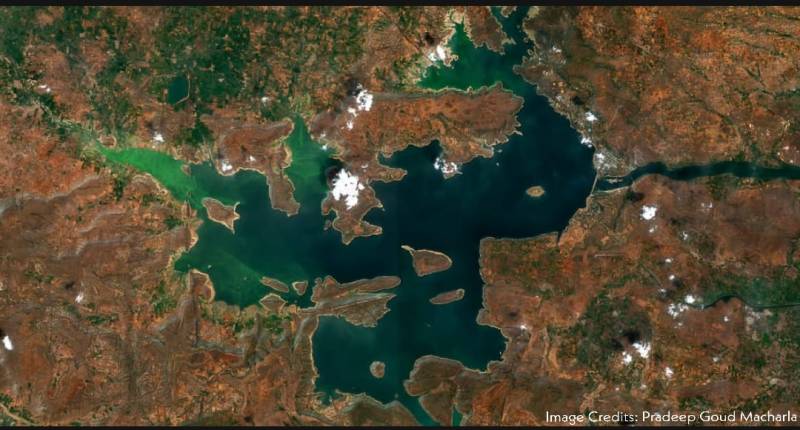Satellite image of Nagarjuna Sagar reveals algal bloom invading the reservoir
By Dheeshma Published on 18 Feb 2020 3:25 AM GMT
Hyderabad: Satellite images of Nagarjuna Sagar reveals that algal blooms are choking the reservoir. The satellite data captured on 12 February shows freshwater algae invading the reservoir. Earlier, NewsMeter had acquired satellite images of several other water bodies that have spotted the presence of algal bloom, including Sriram Sagar, Srisailam, Vaigai, Nagarjuna Sagar, Gandhi Sagar, Indira Sagar, Almatti, and Mettur. The satellite images were acquired by satellite Copernicus EU between September and October 2018.
Dr K. Babu Rao, a retired scientist of the Indian Institute of Chemical Technology (IICT), told NewsMeter, “This is a phenomenon that regularly happens when the temperature starts rising and there is an excess of nutrients in water bodies. As the algal bloom increases, the level of dissolved oxygen content in water bodies reduce. Marine life normally dies off when there is too many algae bloom as they get deprived of oxygen.”
#Algalblooms observed in #NagarjunaSagar Reservoir.
Freshwater algal blooms are probably the result of an excess of nutrients entering the water bodies from agricultural activities upstream(fertilizer runoff).
Satellite Imagery Date: Feb-13-2020@Indian_Rivers @yamunajiye https://t.co/ivbDa9wyJJ pic.twitter.com/G18hlzOxJZ
— Pradeep Goud Macharla 🌍 (@Macharlazz) February 15, 2020
The ‘algal bloom’ could have originated upstream or from nearby agricultural land due to excessive fertiliser usage or release of untreated sewage into these reservoirs, according to experts. When an excess of nutrients enters water bodies algal bloom happens. Once there was a huge algae bloom problem in the Great Lakes area of the United States because of agricultural runoff. Similarly, in Vijayawada’s Prakasam Barrage, hard water from the Ibrahim Patanam thermal plant was discharged into the Krishna river. That had also caused algal bloom on Krishna river many times.
“If Nagarjuna Sagar has algal bloom it may affect the drinking water for Hyderabad. A few years ago because of the algal bloom in Lake Erie near the Niagara falls, the city municipality announced that people shouldn’t drink that water. For three days people survived on bottled water. In Indian cities, we have no such monitoring mechanisms. If there is algal bloom the water body will produce a very foul smell. Algal also produces certain kinds of poisons that can cause chronic neurological diseases like amyotrophic lateral sclerosis and Alzheimer’s. To avoid algal, we should stop the entry of untreated sewage into water bodies. Currently, in Hyderabad the entire sewage of the city is disposed into its water bodies,” Dr Babu Rao said.
Subha Rao, a former scientist at the International Crops Research Institute for the Semi-arid Tropics (ICRISAT), calls the growth of the algae the failure of states to develop a sewage masterplan for cities. He said, “India witnessed rapid physical growth. Across the country, a lot of urbanisation happened. Even small states like Kerala witnessed tourism development. However, in spite of these large scale developments, we do not have a masterplan for the sewage systems in the country. Every authority is permitting construction. But because of the absence of a masterplan for sewage, no authority is assessing the likely increase in the sewage load. Since there is no masterplan, the sewage load is joining the natural drainage.”
Compared to fertilisers used in farm fields, Mr Subha Rao said, untreated waste is the primary source of algal bloom in the country. “Sewage waste and fertilisers are the major contributing sources for algal blooms. But to authenticate the real source, for instance in Mettur dam, we need to study the growth of urbanisation in the upstream of that dam. Agriculture as such is only declining in India. It’s not improving. No new land is coming under irrigation. Probably they might be using more fertilisers and more pesticides. So it’s the increase in fertiliser input and increase in towns and cities.”
In cities like Bangalore, Hyderabad and Chennai, sewage is directly flowing into lakes and from there to rivers or sea. As a result, reservoirs around these cities get affected. Apart from the chemicals from agricultural land, the sewage load nowadays has sharply increased, Mr Rao said. This threatens the country’s water quality as a whole and will also have a negative impact on agriculture systems.
